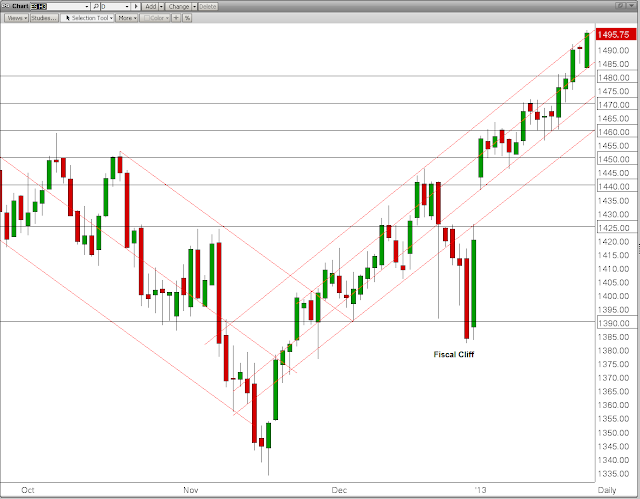jessescrossroadscafe.blogspot.com
24 January 2013 Bernanke's Hammer: When Everything Looks Like Currency
"I suppose it is tempting, if the only tool you have is a hammer, to treat everything as if it were a nail."
Abraham Maslow, The Psychology of Science, 1966
The word that has made its way across the trading desks is that the Fed's put is back on, or more colloquially phrased, while Bernanke keeps printing, certain favored classes of assets can keep going higher, without regard to fundamentals except for signficant event driven incidents, that will be quickly papered over.
As an aside, before snarky propeller heads with little better arguments to make point out that the Fed does not literally print money, we all know that. It is a degenerate profession that mixes a pretension to lofty equations and high science with the taunts and arguments of the schoolyard.
The pity is that 'the printing press' is not the only instrument at the Fed's disposal. After all, they are a significant regulator of the banks, and have gained even more power since the financial crisis. But as might be obvious to most, they are a terribly conflicted regulator, and given to remarkable lapses in judgement.
The meme on the financial markets is that there may be shallow pullbacks, or even a greater correction in response to a specific event, such as the 'fiscal cliff,' but the Fed's policy is to target asset inflation, through the Too Big To Fail Banks and hedge funds.
There is also a belief, whether it is right or wrong, that the regulators will turn a blind eye to the capping of certain commodities like gold and silver, in the name of managing them as currencies. Even a folk hero like Paul Volcker has previously endorsed this as a policy.
This turning of things upside down is what has been called Rubinomics, the principle that by supporting the buying of certain select instruments such as SP futures ahead of a crisis, one can more efficiently avert a financial problem than by allowing the markets to reflect the fundamentals, and then to clean up the mess afterwards. It's cheaper and easier he observed.
It is the belief that rather than an instrument of price discovery within the real economy, the financial markets ARE the economy, and will lead rather than follow.
It should also be noted that Robert Rubin articulated this while he was the Secretary of the Treasury, and he somehow persuaded Greenspan, then the Chairman of the Fed, to go along with it, shortly after the Maestro had made his famous 'irrational exuberance' speech.
And this is the problem I have with a Modern Monetary Theory that would save the system by placing the ability to simply create money in the hands of the Treasury, to be wielded such titans of sound judgement as Robert Rubin, Hank Paulson, and Tim Geithner, with oversight perhaps by those incorruptibles and paragons in the Congress.
I don't like the banking system as it is. But the solution seems obvious, which is to reform it, to provide for transparency and the rule of law, and not to replace it with some gimmicky solution that has the same faults or worse.
So what about the markets, and such similar notions as 'Nominal GDP Targeting." Well, we can wonder how the Fed might want to actually achieve such a thing, short of going out and buying iPhones and foodstuffs. Would it be to continually stuff money into the banks and their associated companies and camp followers, and wait for the trickle down effect?
We have seen the result of such an approach in the past. The 'hot money' seeks beta, and that means financial paper, and frauds like collateralized debt obligations, tied to whatever hapless aspect of the real economy that is convenient, such as housing for example.
And the self same snarky economists will say, 'Where is the inflation?' and point to the very instruments of measurement of inflation that have been distorted and disabled so as not to show it, 'Chained CPI' being the most recent aberration. And they know full well that in a situation in which the money supply is being expanded selectively and distributed through a relatively narrow source like the biggest banks, the inflation will show up selectively for quite some time, in inflated assets, bonuses and even industries like the tech sector if one can remember back to the 1990's.
I know how tempting it is for 'a little boy with a hammer' to go about pounding everything in sight. But at some point, the adults have to come and take away that hammer, and restore the instrument to its proper usage in the service of real work and creative, productive activity.
Be careful in this market. In markets where stocks trade like commodities, the technicals tend to be dominant because the market is a cynical game of supply and demand, squeezes in both directions, divorced from the underlying economic fundamentals. And it has been made worse by the light volumes, as few bystanders want to put their money down on the three card monte table.
 |




